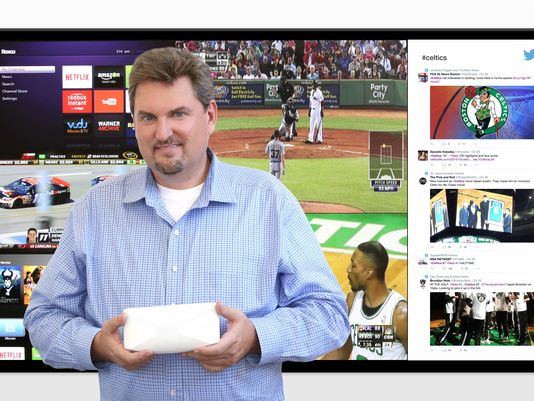SkreensTV wants to revive the family TV tradition


Marc Todd holds his SkreensTV device, which routes multiple sources of video onto a central home television.(Photo: SkreensTV)
There once was a time when the family gathered around the living room TV. Then the tech era armed everyone but the family dog with their own personal screen. Now Marc Todd wants to go back to the future.
SkreensTV, whose Indiegogo campaign launches Thursday, is a $399 ($499 after the crowdfunding campaign) 7-by-2-inch WiFi- and Bluetooth-enabled box with five HDMI outputs and storage capacity ranging from 4 to 64 GB. SkreensTV routes the action from multiple devices – cable box, computer, gaming console, streaming TV – onto one screen.
A custom app turns your tablet or phone into a remote that allows you to customize the size of each screen projected onto your TV. One video source can use the TV's speakers for audio, while the other four audio tracks can be accessed by wireless headphones.
That's right, Todd is convinced folks are so desperate to be together they'll put up with a giant home TV with warring images of sports, xBox, and Twitter feeds.
“'It's not the family room now, it's the 'Whoever holds the TV remote' room.'”
SkreensTV founder Marc Todd"It's not the family room now, it's the 'Whoever holds the TV remote' room, but I think people still want to be together even using different devices," says Todd, whose Foxboro, Mass., startup has a financial assist from Pags Group, the investment arm of Bain Capital managing director and Boston Celtics co-owner Steve Pagliuca.
"My kids will be playing a video game while I'm watching the Bruins and the Celtics, but we're in the same place," he says, adding that splitting our video attention is now the norm. "I call it the sports bar effect. Or just think of being on a plane (with satellite TV). You watch your screen but the next guy's, too."
Todd is hoping to piggyback on the proliferation of devices such as Google's Chromecast and Apple TV, which have gotten consumers used to treating their TVs as large monitors pulling in programming from various content sources. Another factor is the dropping cost of once pricey large-screen TVs.
"The fact of the matter is we're all now consuming video content at a very rapid rate," he says. "That said, there are times when I have to admit that depending on what I'm watching I'll just tell the kids, 'Hey, time to get out.'"
Read or Share this story: http://usat.ly/1qFlHjY









